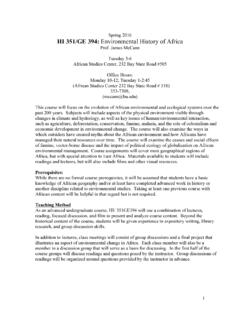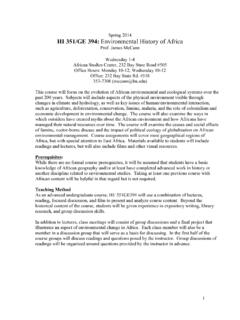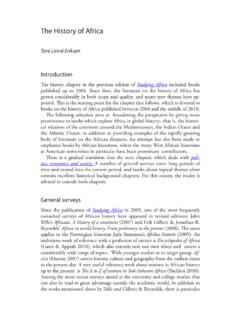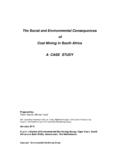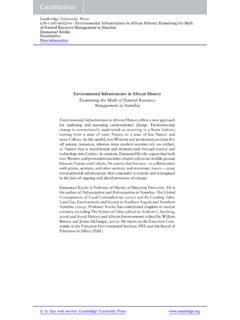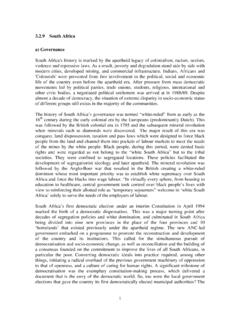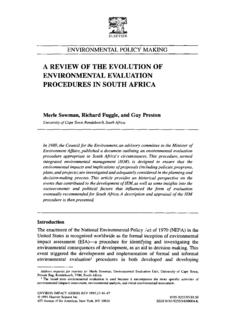Transcription of 4.2 Migrations shaping African history - age-of …
1 Migrations shaping African history Population movements have played an important part in shaping africa and the rest of the world for thousands of years. environmental , economic, cultural and political changes led to large historical Migrations , which helped form African societies and ways of living. These patterns were disrupted and transformed by European colonialism, which brought economic exploitation, political domination and cultural change. The Atlantic slave trade devastated much of western and central africa , while playing a crucial part in the development of the Atlantic economies. The underdevelopment and impoverishment left behind when colonialism receded after 1945 provide the context for today s Migrations within and from africa . The human race originated in the Great Lakes region of africa , and spread to the rest of the world over many millennia.
2 Researchers believe that large-scale African Migrations started around 200 000 years ago with technological innovations that allowed the population to increase in numbers and expand. For example, 15 000 years ago, the people of the Nubia/Red Sea region (present-day Egypt and Sudan) developed the intensive cultivation of wild grains which permitted growth into new territory. Linguistic origins and patterns reflect movement as well. Semitic and Berber languages spread from Ethiopia throughout the Horn of africa , while Nilo-Saharan languages travelled from Sudan to the northern part of Lake Chad. Bantu, which originated in present-day Cameroon at least 5000 years ago, reached the Natal region in South africa . The languages of native inhabitants and their conquerors amalgamated over time to form the incredible linguistic diversity of the African continent today.
3 Climate and ecological changes have also been causes for migration. The creation of the Sahara Desert by 2500 BC separated Sub-Saharan africa from the rest of the world. However, there have been millennia of humid and arid periods, which have had a profound impact on migration into and out of the region. Drought has forced inhabitants to leave many locations throughout the continent. Generally, these movements have been from north to south during arid periods and from south to north when conditions are relatively humid. In pre-colonial times, migration was thus part of normal life in many parts of africa . This included permanent movements to open up new lands or to escape wars and repression, as well as seasonal or circular migration concerned with hunting, trade, agriculture or religion.
4 However, such patterns were often complicated by movements related to trade and conquest, which have long linked africa with other regions in Asia, Europe and the Americas. Around 1000 BC, the Malagasy of the Australia-Polynesia region developed the ability to sail long distances, and travelled to present-day Madagascar, an island off the south-eastern coast of africa . The Muslim conquest of North africa linked the Maghreb, the core of which comprises Morocco, Algeria and Tunisia, with the Middle East. The vast stretches of the Saharan Desert separated the Maghreb from the Sahel and Sub-Saharan africa . The Sahel refers to the region directly south of the Saharan Desert and north of the more fertile regions along the coast of West africa encompassing present-day Senegal, Mauritania, Mali, Burkina Faso, Niger, Nigeria, Chad, Sudan, and Eritrea.
5 Bedouin emigrated from Arabia to North africa , followed by the Banu Hilal and Banu Sulaym who travelled through the Egyptian desert on camelback. The complete Arabisation of North africa occurred after the arrival of the Hilalians who brought Arabic to what is now Tunisia, Algeria, Morocco, and Western Sahara. Nonetheless, many Berbers still speak Tamazight or Berber today. Although slavery s greatest impact occurred with the arrival of Europeans in africa , the slave trade had taken root as early as the fifth century AD and had moved from tropical africa to the Mediterranean Basin and Arabia by the seventh century AD. Present-day Ukraine and other Slavic regions (note the similarity between Slav and the Latin sclavus, meaning slave) north of the Black Sea were also major sources of slaves for the Mediterranean Basin between the twelfth and fifteenth centuries AD.
6 The belief, common in West africa at the time, that every member of a conquered population became a slave greatly affected the societies of the region. As men were too much of a risk to keep around, victorious tribes would sell the males of conquered tribes to merchants from North africa and Europe who needed slaves for agriculture and, later, for the rise of industry and plantations overseas (Curtin, 1997). Existing patterns were disrupted by European colonialism from the 15th century onwards. The Portuguese first arrived on the West African coast in the fifteen century, and were soon followed by the Dutch, British and French. The pioneer African -Caribbean historian Walter Rodney has pointed out that underdevelopment is not a condition but a process. Since early modern times, Europe has developed by under-developing africa : that is by extracting its labour and commodities to build European and American economies, while destroying opportunities for economic and political development in africa (Rodney, 1972).
7 Control of human mobility was always an essential part of colonialism. In the early period of colonialism European traders and military forces seized control of coastal areas, and used these as bases to force Africans into slavery. Diseases such as smallpox, malaria, and yellow fever had had devastating effects on the native populations of the Americas, resulting in considerable depopulation. Europeans thus adopted the practice of shipping Africans to the New World for the labour-intensive production of cash crops such as sugar, cotton and tobacco. At the peak of the slave trade in the late eighteenth century, approximately 80 000 African slaves were transported to the Americas each year, with the Caribbean and Brazil serving as the primary destinations. About 15m slaves were taken to North and South America and the Caribbean from the 16th to the 19th century.
8 The capital accumulated through plantation labour was crucial to European industrialization. At the same time, there was some European migration to africa in the form of soldiers, administrators and traders. Settler colonization ( large-scale permanent immigration) in this period was confined mainly to the Dutch colonial occupation of what is today South africa , after the 1652 landing at the Cape (Mafukidze, 2006: 109). In the imperialist period of the 19th and early 20th centuries, European powers competed for direct control and occupation of africa .. The key aim was extraction of africa s agricultural and mineral wealth. Seizing slaves to take to the New World was no longer economically beneficial for advanced colonial powers like Britain. The European nations divided up africa , destroying existing political structures and drawing new boundaries that cut across tribal territories and historical migration routes.
9 Growing numbers of Europeans came as settlers to establish farms, plantations and mines. Together with white administrators and merchants, they formed a new economic and political elite. Africans were conscripted for forced labour on the plantations and in the mines. Others had to become workers and servants for white farmers on their own ancestral land. Yet others were recruited for building roads, ports and houses for the Europeans, or as soldiers in colonial armies. Mechanisms for getting Africans to do such labour included confiscation of agricultural land (often in order to give the best land to European settlers as in Kenya and Zimbabwe), introduction of money taxes (poll taxes, hut taxes, etc.) to compel workers to enter the new cash economy, as well as use of physical force.
10 In 1860, the Natal region of South africa entered into an indentured labour agreement with the British government in India that led to significant Indian migration to the region over the ensuing decades. In Kenya, the British government brought in Indian labour to construct the Mombasa-Lake Victoria railroad. Today, there are approximately 1 million persons of Indian descent living in Southern africa . Chinese miners were also indentured to work in South africa , but almost all were repatriated after the British government intervened. In the late 19th century, following discoveries of gold and diamonds in South africa , a mine labour system based on temporary migration of young men was developed a blueprint for a key practice of the later apartheid regime. During both world wars, colonial powers recruited African workers and soldiers to Europe to support their military (Mafukidze, 2006; Rodney, 1972; Zlotnik, 2004).

